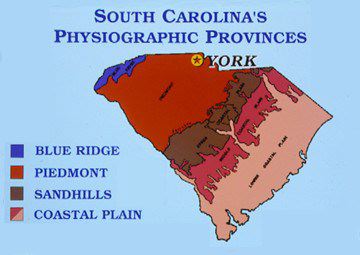 HOME: www.hiltonpond.org |
|||
- The Piedmont Naturalist -
© Bill Hilton Jr.
 HOME: www.hiltonpond.org |
|||
- The Piedmont Naturalist -
© Bill Hilton Jr.
|
The following article is reprinted and revised from |

|
One reason I like living in South Carolina is because its native plants and animals are more diverse than in most other areas of the United States. The diversity results in part from moderate temperatures and adequate rainfall, but vastly different habitats have even greater influence. Our variety of flora and fauna occurs because South Carolina has mountains, foothills, the Piedmont, sandhills, a coastal plain, and the ocean itself. When there are this many habitats, it is nature's way that there will also be many types of organisms. All this helps fuel my interest in the natural world that surrounds us, especially in York County and vicinity. South Carolina lays claim to only a little piece of the mountains in extreme western Oconee, Pickens, and Greenville counties. There, at higher elevations, we find plants, songbirds, and mammals that otherwise aren't found until further north into Pennsylvania or New Engl and. Sassafras Mountain (the highest point in the state at 3,560 feet) and a few other South Carolina ridgetops are all that is left of ancient mountains that were even taller than the modern day Himalayas of Asia. Moving eastward across the state, we see that York County sits astride an ecological zone known as the "Piedmont." (The word "piedmont" itself is rather misleading since it means--translated from the French--"foot of the mountains." The true "foothills" for the southern Appalachian Mountain chain are really west and north of Greenville just before the mountains start.) A quick check of a road map shows that the Piedmont of the Palmetto State is a broad band of land that lies roughly between two Interstate highways--I-85 and I-20. Although most people associate the "piedmont" only with southern states, the region actually extends from southeastern New York, across South Carolina, and into central Alabama. Further east and south of York County, SC, lie the state's "sandhills," whose western border follows the "fall line." This fall line, stretching north from Augusta, Georgia, through Columbia to Fayetteville, North Carolina, is the ancient shoreline of the Atlantic Ocean. During warm periods in the earth's history, polar ice caps melted and the seas were deeper. At the fall line, upland rivers cascaded over towering cliffs into the ocean, forming what must have been a series of spectacular waterfalls. Today's narrow ribbon of sandhills slopes into the vast and nearly level coastal plain, itself bordered on the east by the sandy beaches of Cherry Grove, Myrtle Beach, Garden City, and points south. The mountains of South Carolina are well-studied from the natural history perspective, as are our coastal areas. Even among field naturalists and ecology graduate students there seem to be preferences for spending time in the cool green of the mountains or the balmy, sun-drenched coastal zones, and science knows a lot about the plants and animals of these regions. The Piedmont, however, is quite a nother matter. There is much to see and study right in our own backyards around Fort Mill and Clover and Rock Hill and Sharon. Too often Piedmont birdwatchers grow tired of seeing Northern Cardinals and Purple Finches all winter and drift toward the beach for glimpses of shorebirds and waterfowl. York County plant lovers seem drawn each spring to the diverse wildflower bloom in the mountains, even though we have substantial numbers of flowering wild plants all over the county. Despite the fact that it covers nearly half the land area of the state, South Carolina's Piedmont has been ignored by the majority of nature buffs, both past and present, and this column is a humble attempt to get people "turned on" to the natural history in our own "backyard." Through this column I hope to report on various aspects of nature in York County and the Piedmont region of which it is a part. My goal is to instill renewed appreciation for the natural wonders of this "overlooked" biogeogaphical region, and to talk about how the Piedmont of South Carolina is similar to but very different from the Piedmont of Pennsylvania and Georgia and points in between. I hope to hear from readers who spot unusual Piedmont plants or animals, or who notice some interesting phenomenon in the natural world that rewards us so intensely when we take time to look. My own special interest is birds, but countless field trips by myself and with my students from Northwestern and Fort Mill high schools have generated enthusiasm in me for everything from spiders to sycamores and from swamps to sunsets. As a teacher, there's nothing I enjoy better than sharing my experiences with anyone who will listen, or read. All text, drawings & photos © Hilton Pond Center |
Up to Top of Page
Back to Piedmont Naturalist Volume 1 (1986)
|
Make direct donations on-line through
Network for Good: |
|
|
LIKE TO SHOP ON-LINE?
Donate a portion of your purchase price from 500+ top on-line stores via iGive: |
|
|
Use your PayPal account
to make direct donations: |
|
 post questions for The Piedmont Naturalist |
Join the |
Search Engine for |
|
|